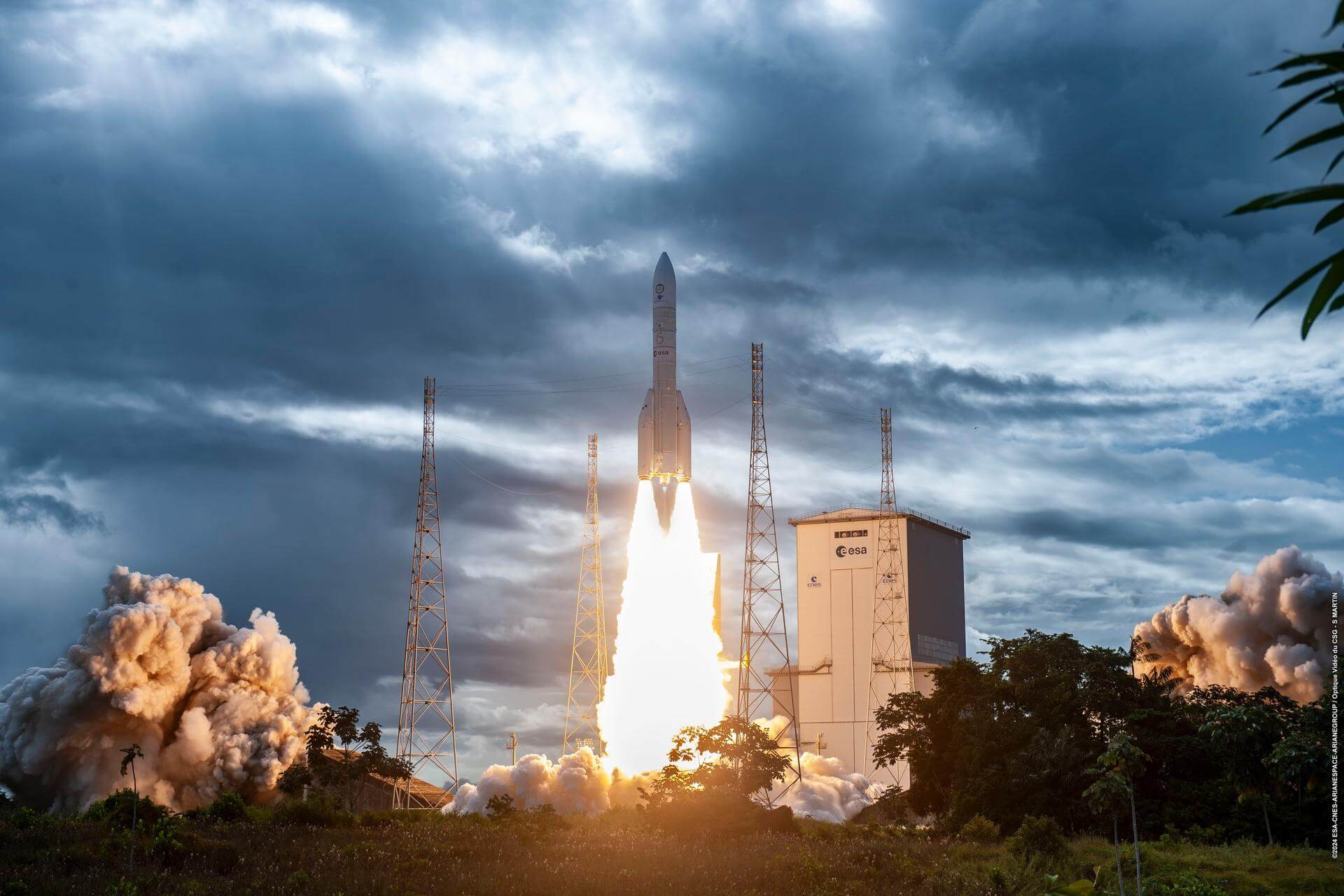· space brief · 6 min read
Space Brief 30 Aug 2025
Today's briefing covers the latest satellite communications advancements, a secretive military launch by SpaceX, and new space defense organizational structures.

📄Top Stories
In significant space news today, Assured Space Access Technologies unveils the next-gen CapLink Array, boosting missile defense and satellite communications. Meanwhile, SpaceX successfully launched the secretive X-37B military spacecraft for the U.S. military. Also, the U.S. Space Force enhances its integration capabilities with the activation of Systems Delta 85.
📰Detailed Coverage
Revolutionizing Satellite Communications: CapLink Array
Assured Space Access Technologies has introduced the CapLink Array, a state-of-the-art phased array antenna designed to significantly enhance the capabilities of missile defense systems and space-based communications. The system boasts advanced features like a capacitive dipole design that supports broad frequency bandwidth and high gain with a wide field-of-view.
This technological breakthrough is pivotal for satellite tracking, particularly in complex operations where precise, reliable communication is necessary. Our web app allows users to follow these advancements and understand the implications for satellite systems.
Read the full story: Space War
SpaceX’s Secretive Military Launch
On Thursday night, SpaceX launched a Falcon 9 rocket carrying the U.S. military’s secretive X-37B spaceplane from NASA’s Kennedy Space Center. This mission, which is part of the U.S. military’s ongoing efforts to maintain strategic superiority in space, saw the rocket illuminate the night sky as it ascended.
While the mission specifics remain classified, the launch underscores the role of private companies like SpaceX in bolstering military capabilities in orbit. This development showcases the growing intersection of commercial space ventures and national defense strategies.
Read the full story: Space War
A New Chapter in Space Defense: Systems Delta 85
The U.S. Space Force has launched Systems Delta 85, a new organizational structure aimed at enhancing the integration of space defense into broader military strategy. Led by Col. Jason West, this initiative unites acquisition and operational support to streamline space defense efforts.
The establishment of Systems Delta 85 reflects a growing recognition of the importance of cohesive command structures in space defense operations. As space becomes an increasingly contested domain, improved coordination and management will be crucial for effective defense strategies.
Read the full story: Space War
Japan’s Ambitious Defense Budget Proposal
Japan has proposed a $60 billion defense budget that includes funding for a multilayered coastal defense network and additional F-35 fighter jets. This request comes amid increasing regional security concerns and aims to enhance Japan’s defense capabilities.
Particularly noteworthy is Japan’s focus on integrating advanced U.S. military technologies, such as KC-46 aerial refueling tankers, to bolster its strategic assets. This move reflects Japan’s commitment to strengthening its national defense infrastructure in collaboration with international allies.
Read the full story: Breaking Defense
Addressing Nuclear Proliferation Threats
In efforts to curb nuclear proliferation, there’s a rising narrative emphasizing the role of STRATCOM in ensuring that the U.S. maintains a strategic deterrent capable of responding to emerging threats. This approach is part of a broader strategy to modernize nuclear forces while addressing proliferation challenges.
The discourse around nuclear deterrence strategy signifies a shift towards enhanced defense readiness at a time of geopolitical tensions. By aligning resources to mitigate nuclear threats, the focus aims to strengthen both national and global security frameworks.
Read the full story: Breaking Defense
Task Force 401: Leading Counter-UAS Efforts
The U.S. Army has been assigned to spearhead Task Force 401, which focuses on countering threats posed by small unmanned aerial systems (UAS). With an emphasis on securing procurement capabilities, this initiative marks a concerted effort to address the challenges presented by evolving UAS technologies.
As small UAS become more prevalent, the Army’s leadership in this domain is critical to ensuring that measures are in place to protect against these emerging threats. This focus on counter-UAS technologies highlights the evolving landscape of military defense.
Read the full story: Breaking Defense
🛰️Satellite Spotlight
- Satellite Name: OPS 1264 (DMSP 4A F4)
- NORAD ID: 02980
- Launch Date: October 11, 1967
- Mission: The DMSP (Defense Meteorological Satellite Program) satellites, including this one, were primarily designed for meteorological observations, providing essential weather data for military operations.
- Orbit: Low Earth Orbit (LEO)
- Operator: SAMSO (Systems Acquisition Management System Office)
- Fun Fact: OPS 1264 is part of the DMSP Block 4A series, which was instrumental in transitioning military weather forecasting from ground-based observations to satellite data.
Track this satellite in real-time on our web app: Track OPS 1264 (DMSP 4A F4)
🌌Space Weather
Current space weather shows High solar flux (222).
Current
R0 - S0 - G0
Last 24 Hour Maximums
R0 - S0 - G0
Recent Alerts
[]
Next 24 Hours
-
Radio Blackouts Probability
- Minor: 75
- Major: 20
- Risk: None
-
Solar Radiation
- Probability: 20
- Risk: None
-
Geomagnetic Storming
- Scale: 0
- Impact: none
- Activity: Low
-
Impact Summary
- Next 24 hours: No risk of radio blackouts.
- No risk of solar radiation storms.
- Geomagnetic outlook: No G1 (Minor) or greater geomagnetic storms are expected.
- No significant transient or recurrent solar wind features are forecasted.
Long Term Forecast
- Forecast of Solar and Geomagnetic Activity 25 August - 20 September: Solar activity is expected to be at low levels, with varying chances for M-class flares (R1-R2/Minor-Moderate events) through 20 Sep.
- The greater than 10 MeV proton levels are expected to be at or above 10 pfu levels on 25 Aug before dropping below the 10 pfu level by 26 Aug.
- Levels should remain below thresholds through 20 Sep, with no additional events expected at geosynchronous orbit.
- The greater than 2 MeV electron flux at geosynchronous orbit is expected to be at moderate levels on 25-26 Aug, 29 Aug-5 Sep, and 15-19 Sep.
- Conditions are likely to see high levels on 27-28 Aug, 6-14 Sep, and again on 20 Sep.
- Geomagnetic field activity is expected to be at mostly quiet levels on 29 Aug-3 Sep and again on 11-14 Sep.
- Unsettled levels are likely on 25-28 Aug, 7-10 Sep, and 17-20 Sep.
- Active conditions are likely on 4-9 Sep and 15-16 Sep, with possible minor storming on 4-6 Sep and 15 Sep.
- All increased activity levels are associated with coronal hole high-speed stream influence.
🚀Upcoming Space Launches
August 31
- SpaceX Falcon 9:
- Starlink Group 10-14 from Cape Canaveral Space Force Station (11:15 UTC) A batch of 28 satellites for the Starlink mega-constellation - SpaceX’s project for space-based Internet communication system.
September 3
- SpaceX Falcon 9:
- Starlink Group 17-8 from Vandenberg Space Force Base (02:33 UTC) A batch of 24 satellites for the Starlink mega-constellation - SpaceX’s project for space-based Internet communication system.
- SpaceX Falcon 9:
- Starlink Group 10-22 from Cape Canaveral Space Force Station (11:06 UTC) A batch of 28 satellites for the Starlink mega-constellation - SpaceX’s project for space-based Internet communication system.
September 4
- SpaceX Falcon 9:
- Starlink Group 10-57 from Kennedy Space Center (11:18 UTC) A batch of 28 satellites for the Starlink mega-constellation - SpaceX’s project for space-based Internet communication system.
September 6
- SpaceX Falcon 9:
- Starlink Group 17-9 from Vandenberg Space Force Base (15:42 UTC) A batch of 24 satellites for the Starlink mega-constellation - SpaceX’s project for space-based Internet communication system.
September 8
- SpaceX Falcon 9:
- Nusantara Lima from Cape Canaveral Space Force Station (00:00 UTC) Nusantara Lima is an Indonesian geostationary communications satellite with a capacity of more than 160 Gbps.
September 10
- SpaceX Falcon 9:
- SDA Tranche 1 Transport Layer B from Vandenberg Space Force Base (00:00 UTC) Classified mission launched by the Space Development Agency (SDA) for Tranche 1 Transport Layer.
September 11
- ROSCOSMOS Soyuz 2.1a:
- Progress MS-32 (93P) from Baikonur Cosmodrome (13:49 UTC) Progress resupply mission to the International Space Station.
September 15
- SpaceX Falcon 9:
- Cygnus CRS-2 NG-23 from Cape Canaveral Space Force Station (22:00 UTC) This is the 23rd flight of Northrop Grumman’s uncrewed resupply spacecraft Cygnus and its 22nd flight to the International Space Station under the Commercial Resupply Services contract with NASA.
Note: Launch dates and times are subject to change due to technical or weather considerations.

Maurice Stellarski




